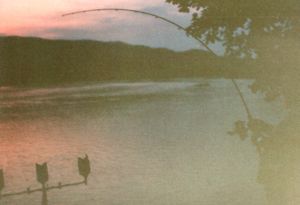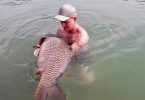{This article was written by Budgie a number of years ago, when he was running his own catfish guiding service. He’s allowed us to reproduce it, as the information is pretty much as relevant today as it was back then. Tackle may have changed slightly in the past few years, but the way you select it hasn’t. This tackle guide should give you some ideas on how to go about choosing the right catfish fishing tackle for your own needs.
If you see a term underlined, this means that it is linked. Click on it to be taken to examples of that product for sale -Ed}
People often ask me what sort of tackle I use to catch big continental Catfish. When I show them, they are often most surprised. The tackle that friends, customers and myself use looks not unlike standard UK cat gear. Most expect to see sea fishing rods and huge lever drag multipliers loaded with 40lb+ line. In this article I will try to give you an insight in to the equipment I use and how its selection came about.
Once the idea of travelling abroad to catch big Cats had been sown, my first concern was as to what tackle to use. We had found that 2lbTC through action rods combined with 12lb BS line were perfect for catching fish up to 30lb in the UK. The through action, used correctly, tired the fish a lot quicker than substantially more powerful rods of a fast taper design. We surmised that a 4lb TC rod of a similar action would be a good starting point, but where would we get such a tool?
Whilst at the 1992 N.A.S.A. Conference, we approached most of the major blank manufacturers with the design brief of a Mk IV/SS5 carp rod with a test curve of 4lb and a length of 12ft. To my utter amazement, most of the people on the various stands didn’t know what either of these rods were. The young fellow on the North Western stand said he had never heard of an SS5! Some laughed at our request; “What you after, sharks? What you want is…” Most just tried to sell us their latest 3 1/2lbTC long range carp snooker cue! We were not making very good progress, but then things changed. We were looking at the rods on the Bruce & Walker stand when Brian Potter approached us and enquired as to what we were looking for. When we mentioned “Mk IV” to him, he knew exactly what we wanted, and went on to say that such a rod, constructed from carbon, would prove an interesting challenge to a blank manufacturer and that he would do his best to produce what we required.
Several months passed and then I received a phone call from Brian. He told me that he had made several blanks and discarded them, but now had some thing he would like us to try. My fishing partner, Rob Dixon, was due to visit his mother (who lives near Bruce & Walker’s Huntingdon factory) that weekend, so it was arranged for him to pick up the first prototype blank. When Rob arrived back at my home, we immediately took the blank out to my workshop. From the initial bending of the blank we felt quite confident that this would do the job. Once I built the rod up we used it on trips to Claydon and Rackley Hills. We didn’t hook one of the big fish in Rackley, but Rob did manage to land a 33lbs Catfish from Claydon, which the rod obviously handled with ease. During the winter the rod was used for heavy duty Piking, casting baits of over 1lb well over 60 yards. We were now quite happy with the rod and for bank fishing this rod has proved more than adequate, the first fish it landed being a mighty 101lbs. It’s through action lands even treble figure Cats quite comfortably in less than seven minutes! Try reading the stories other people write about their hour long battles with kittens on Uptide or Boat rods. Either these people don’t pull very hard or the tackle is wrong, I will let you make your own minds up!

THE 4lb TC 12’BRUCE & WALKER CONTINENTAL CATFISH ROD DOING IT’S STUFF!
The choice of reel is simple, the Shimano Baitrunner 6500 being the only choice. This reel has its faults (the rotor shaft actually bending when you pump a big Cat is one!), but no other reel on the market that I have tried has the necessary combination of fully adjustable free spool, line capacity and reliable drag. Despite my preference for “backwinding” whilst playing most other fish, the use of the drag is much more effective for landing large Cats quickly. For fishing close in, the 4500 is more than adequate.

THE SHIMANO BAITRUNNER 6500
 Originally, we used to load up with 25lb Maxima monofilament. This was more than capable of landing these monster fish and dealing with the heavy abrasion caused by the many rocks close in. I now tend to use an equivalent diameter braid. Note that I said diameter, not Breaking Strain (BS). I have found that, when using braid, choosing the same BS gives you a much smaller diameter. This drastically reduces your abrasion resistance. The change to braid ensures better hook up ratios (especially on the “far bank” rigs) due to its lack of stretch. I have used many various types/makes of braid and have found most to be usable. My personal preference, however, is for Spiderwire. This is, unfortunately, mega expensive, but due to the kind people at LEEDA, I am able to get it at an affordable price. I used to change mono every trip, but the braid normally lasts a year. For a one off trip, though, I would happily recommend Maxima Marine Green, a cheap but very tough line.
Originally, we used to load up with 25lb Maxima monofilament. This was more than capable of landing these monster fish and dealing with the heavy abrasion caused by the many rocks close in. I now tend to use an equivalent diameter braid. Note that I said diameter, not Breaking Strain (BS). I have found that, when using braid, choosing the same BS gives you a much smaller diameter. This drastically reduces your abrasion resistance. The change to braid ensures better hook up ratios (especially on the “far bank” rigs) due to its lack of stretch. I have used many various types/makes of braid and have found most to be usable. My personal preference, however, is for Spiderwire. This is, unfortunately, mega expensive, but due to the kind people at LEEDA, I am able to get it at an affordable price. I used to change mono every trip, but the braid normally lasts a year. For a one off trip, though, I would happily recommend Maxima Marine Green, a cheap but very tough line.
In the UK, we had always used the Cox & Rawle Uptide Extra hooks but, unfortunately, in the 6/0 plus sizes you require abroad they are not as good in my opinion. However, the Meat Hook made by the same firm is perfect in sizes 6/0 and 8/0. Due to the thickness of the wire, care must be taken to ensure that they are correctly sharpened. The best tool for this that I have found is the Diamond Eze-lap hook sharpener. These are quick, simple and idiot proof – they must be if I can use one! When you can drag the hook point over your thumbnail and the point digs in it is sharp enough. The only other hook I use is kept purely for use with eel live baits and is the Maruto Eaglewave. This hooks unique shape holds an eel perfectly and is also the only hook that I have ever found to be usable straight from the packet, it even passes the thumbnail test. As with most of the tackle that I seem to prefer, it requires a second mortgage to purchase a packet! As I still haven’t found anyone to scrounge them from cheap, they are used for those special eel-occasions!
 All of the major items of tackle already mentioned were relatively easy to acquire when compared to the landing and fish welfare equipment. The first thing on the list was a landing net (contrary to most of the “experts”, I still prefer a landing net over hand landing when bank fishing). This was built myself to the same design as the one developed by Rob and used by us both in the UK, the only difference being the size. The arms are made from 30lb Boat rod blanks and measure 67”. The spreader block is made of cast alloy and was kindly made for us by well known eel angler, Steve Markwell, during his lunch break. The netting was made by myself from some old trout cage netting; it took nearly thirty-two hours to sew up! The most important feature of this net, and I am sure what makes it more usable than many others is, the shape. As you can see from the picture it is a lot narrower than a conventional specimen net. The length of the “bag” created by the netting is also much longer than the distance from the spreader block to the cord. This allows even giant Cats to be easily netted without the landing net having to be too big and cumbersome.
All of the major items of tackle already mentioned were relatively easy to acquire when compared to the landing and fish welfare equipment. The first thing on the list was a landing net (contrary to most of the “experts”, I still prefer a landing net over hand landing when bank fishing). This was built myself to the same design as the one developed by Rob and used by us both in the UK, the only difference being the size. The arms are made from 30lb Boat rod blanks and measure 67”. The spreader block is made of cast alloy and was kindly made for us by well known eel angler, Steve Markwell, during his lunch break. The netting was made by myself from some old trout cage netting; it took nearly thirty-two hours to sew up! The most important feature of this net, and I am sure what makes it more usable than many others is, the shape. As you can see from the picture it is a lot narrower than a conventional specimen net. The length of the “bag” created by the netting is also much longer than the distance from the spreader block to the cord. This allows even giant Cats to be easily netted without the landing net having to be too big and cumbersome.
On our first trip to Spain, we took a large piece of carpet underlay, which when soaked in water could be used as an unhooking mat. All moving of fish was done in the collapsed landing net. This proved to be most unsatisfactory and extremely hard work. The weigh sling I had fashioned from some hard wearing rubberised tarpaulin worked fine, but the excessive handling of the fish i.e. from net to mat, to sling, to net etc. worried me. The water obviously normally supports these massive fish’s bodies and internal organs. Being out of their natural element must put extreme pressure on them. Speed of their return to the water and minimum handling must be important. The piece of equipment shown below I call my Cat sling. It was based on the cradle/stretchers that you see dolphins moved about with. It makes moving the fish much easier and doubles as an unhooking mat and weigh sling as well. This greatly reduces the amount of handling required. A thin film of water over this reduces the loss of protective slime. Beware of too much water on the mat, otherwise the normally docile Cats try to swim off!

THE OLD METHOD – A BIT PANTS

TWO TREBLES ON THE CAT SLING
After the time I have spent fishing for these magnificent creatures, I have more than enough trophy shots in my album. Unless the fish is a possible PB, unusual in appearance or circumstances of capture, I prefer to return them after unhooking them in the water. This obviously reduces the stress to the fish and my ageing back! However, the photo is understandably one of the most important parts of the trip for my customers. Due to this, the need sometimes arises for the Cat to be retained until perfect photography conditions are available. The best method for this is to use a “stringer”.
A stringer is a length of soft cord passed through the fish’s mouth and out of the gill cover and tied in a loop; no holes need to be made. The loop is then attached to a length of cord long enough to enable one end to be secured to the bank and the fish to swim down to the bottom of the river and rest. This, although being a rather unusual method for English anglers, is much better than any tube, sack or keep net. On a stringer, the Cat can breathe easily; sacks suffocate them. Without exception, every angler I have ever met who objects to stringers has never used them! One word of advice, though, always check the construction of your home made stringers very carefully. I learnt this the hard way by losing my first ever 100lb Cat before a photo was taken due to a faulty stringer design.

STRINGER, BOLT CROPPERS AND HANDLING GLOVE
It goes with out saying that your normal set of Avon scales won’t be up to the job! With 200lb+ Cats now on the cards, a suitable set must be purchased. Several manufacturers produce scales up to the job, but remember to always subtract the weight of your sling. Some Catfish sized slings can weigh up to 20lb!
Well that just about covers the tackle I use from the bank. I will go in to terminal tackle and rigs in a future article. Later in the year, and especially in Italy, we fish exclusively from a boat using the unusual method of “clonking”. This can be such a devastating tactic that I think it is worth an article of its own.
Budgie










